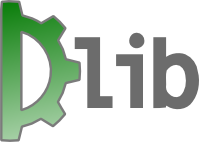Dlib is a general purpose cross-platform software library written in the programming language C++. Its design is heavily influenced by ideas from design by contract and component-based software engineering. Thus it is, first and foremost, a set of independent software components. It is open-source software released under a Boost Software License.
 | |
| Original author(s) | Davis E. King |
|---|---|
| Initial release | 2002 |
| Stable release | 19.24.6[1]
/ 9 August 2024 |
| Repository | |
| Written in | C++ |
| Operating system | Cross-platform |
| Type | Library, machine learning |
| License | Boost |
| Website | dlib |
Since development began in 2002, Dlib has grown to include a wide variety of tools. As of 2016, it contains software components for dealing with networking, threads, graphical user interfaces, data structures, linear algebra, machine learning, image processing, data mining, XML and text parsing, numerical optimization, Bayesian networks, and many other tasks. In recent years, much of the development has been focused on creating a broad set of statistical machine learning tools and in 2009 Dlib was published in the Journal of Machine Learning Research.[2] Since then it has been used in a wide range of domains.[3][4][5][6][7][8][9][10][11][12][13][14][15]
See also
editReferences
edit- ^ "Release 19.24.6". 9 August 2024. Retrieved 22 August 2024.
- ^ King, D. E. (2009). "Dlib-ml: A Machine Learning Toolkit" (PDF). J. Mach. Learn. Res. 10 (Jul): 1755–1758. CiteSeerX 10.1.1.156.3584.
- ^ Scholarly research using Dlib
- ^ Dlib on mloss.org
- ^ Autonome Mobile Systeme 2009
- ^ ESS: Extremely Simple Serialization for C++
- ^ Gould, S. (2012). "Darwin: A Framework for Machine Learning and Computer Vision Research and Development" (PDF). J. Mach. Learn. Res. 13 (Dec): 3533–3537. CiteSeerX 10.1.1.413.8518.
- ^ Yan, Junchi, et al. "Online incremental regression for electricity price prediction." Service Operations and Logistics, and Informatics (SOLI), 2012 IEEE International Conference on. IEEE, 2012. Yan, J.; Tian, C.; Wang, Y.; Huang, J. (2012). "Online incremental regression for electricity price prediction". Proceedings of 2012 IEEE International Conference on Service Operations and Logistics, and Informatics. p. 31. doi:10.1109/SOLI.2012.6273500. ISBN 978-1-4673-2401-4. S2CID 19017900.
- ^ Kuijf, Hugo J., Max A. Viergever, and Koen L. Vincken. "Automatic Extraction of the Curved Midsagittal Brain Surface on MR Images." Medical Computer Vision. Recognition Techniques and Applications in Medical Imaging. Springer Berlin Heidelberg, 2013. 225-232. Kuijf, H. J.; Viergever, M. A.; Vincken, K. L. (2013). "Automatic Extraction of the Curved Midsagittal Brain Surface on MR Images". Medical Computer Vision. Recognition Techniques and Applications in Medical Imaging. Lecture Notes in Computer Science. Vol. 7766. p. 225. doi:10.1007/978-3-642-36620-8_22. ISBN 978-3-642-36619-2.
- ^ Bormann, Richard Klaus Eduard. "Vision-based place categorization." (2010).
- ^ Brodu, Nicolas, and Dimitri Lague. "3D terrestrial lidar data classification of complex natural scenes using a multi-scale dimensionality criterion: Applications in geomorphology." ISPRS Journal of Photogrammetry and Remote Sensing 68 (2012): 121–134.
- ^ Aung, Zeyar, et al. "Towards accurate electricity load forecasting in smart grids." DBKDA 2012, The Fourth International Conference on Advances in Databases, Knowledge, and Data Applications. 2012.
- ^ Rodriguez, Alberto, et al. "Abort and retry in grasping." Intelligent Robots and Systems (IROS), 2011 IEEE/RSJ International Conference on. IEEE, 2011. Rodriguez, A.; Mason, M. T.; Srinivasa, S. S.; Bernstein, M.; Zirbel, A. (2011). "Abort and retry in grasping". 2011 IEEE/RSJ International Conference on Intelligent Robots and Systems. p. 1804. doi:10.1109/IROS.2011.6095100. ISBN 978-1-61284-456-5. S2CID 6637718.
- ^ Mohan, Vandana, et al. "Intraoperative prediction of tumor cell concentration from Mass Spectrometry Imaging." Int. Symp. Math. Theo. Netw. Syst. 2010.
- ^ Nakashima, Yuta, Noboru Babaguchi, and Jianping Fan. "Detecting intended human objects in human-captured videos." Computer Vision and Pattern Recognition Workshops (CVPRW), 2010 IEEE Computer Society Conference on. IEEE, 2010. Nakashima, Y.; Babaguchi, N.; Fan, J. (2010). "Detecting intended human objects in human-captured videos". 2010 IEEE Computer Society Conference on Computer Vision and Pattern Recognition - Workshops. p. 33. doi:10.1109/CVPRW.2010.5543721. ISBN 978-1-4244-7029-7. S2CID 16767135.